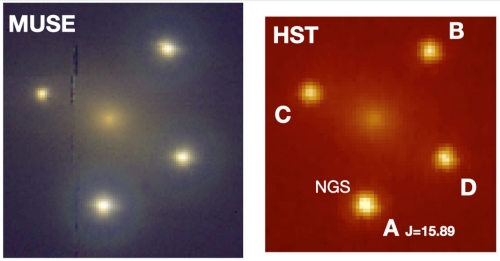Between 12th and 18 July 2021 the second commissioning of the upgraded InfraRed Low-Order wavefront Sensor of MUSE, IRLOS, was carried out through an efficient collaboration between the local Paranal team and the remote support team in Garching. The goal of the IRLOS upgrade, which uses a new SAPHIRA detector with sub-electron readout noise, was to add at least two magnitudes to the limiting magnitude of the adaptive optics module GALACSI Narrow-Field Mode. Moreover, the low-order loop frame rate was increased to 500 Hz for brighter targets. The results of the second commissioning show that those goals have been met or exceeded.
Second Commissioning of IRLOS+, the Upgraded InfraRed Low-Order Wavefront Sensor of MUSE

During the second commissioning the team’s ambition was to deliver a faint mode extending the limiting magnitude beyond the original project’s goal. This was deemed possible thanks to the extensive modelling done during the project. All operational modes were also fine-tuned. Despite the challenge of working remotely and encountering unfriendly weather conditions, the new goal was achieved. Indeed, the limiting magnitude could be extended by 2 additional magnitudes in J, enabling observations down to J=18.5 in turbulence categories 10% to 50%, and down to J=19.0 for turbulence category of 10% and airmases smaller than 1.2. The current IRLOS is thus able to go fully 4 magnitudes fainter than the original one. At the same time the capabilities to observe brighter targets were enhanced to automatize the process of inserting filters and widening the laser constellation. It is now possible in principle to do observations in the range of magnitudes between 0.5 and 19.3, although the system is offered only for low-order reference objects in the range 5.5 to 19.0.
Preliminary results show that the performance is better than the best achieved performance prior to commissioning IRLOS+. Under all conditions of coherence time and seeing higher Strehl ratios and a smaller core PSF FWHM are obtained. It will be possible now to even extend the operational range from coherence times of 3.1 ms, down to 2.5 ms, at least for low airmasses.
The accompanying figure shows an observation of the Einstein cross using one of the quasar images, with J=15.9, for low-order sensing. This target which was impossible with the original IRLOS is now in the easy, bright, range of IRLOS+.
Full performance figures will be given after the commissioning data has been fully reduced and posted in the MUSE News page. Further information can be obtained from the User Support Department.
